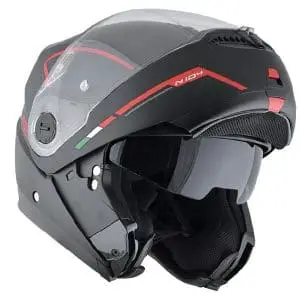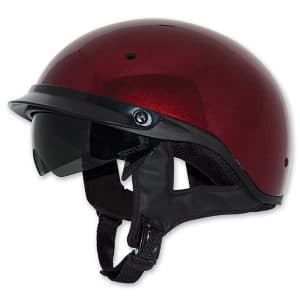THE DEFINITIVE MOTORCYCLE HELMET BUYING GUIDE
How To Choose The Right Motorbike Helmet
This definitive helmet-buying guide is all you need to read to help you choose the right motorbike helmet. You probably know that selecting the perfect helmet is incredibly important. You need to stay safe as you ride your motorbike, whether you’re doing it for fun or you’ve got somewhere to be. Ensuring you have all of the safety gear you need is a must, such as the right type of shoe and the trousers you wear, but the helmet is one of the most important things. Read on to ensure you choose the right helmet for your needs:

Motorcycle Helmet Laws
The provinces of Canada are unified in their approach to motorcycle helmets, making this so easy to understand for riders. The motorcycle laws are consistent across all ten provinces and three territories. The rule is clear: all riders on a motorcycle must wear a crash helmet at all times. It doesn’t make a difference regarding age, speed, passengers, or anything else. All passengers must wear a helmet at all times. This differs from the United States, where laws can get complicated depending on age, experience, and other factors. The laws also vary from state to state. Your helmet must also meet Canada’s helmet health and safety standards for you to wear it legally. Make sure you know the motorcycle laws anywhere you choose to ride to be on the safe side. It’s a good idea always to wear a safety helmet, regardless of the laws, though!
Types of Motorcycle Helmets
There are many factors to consider when choosing a helmet, not just the type of helmet that is right for you. You must consider the material, which should be made using a lightweight plastic-like carbon or kevlar. Visibility is a crucial factor, as well as the controls, weight, and aerodynamics. We’ll discuss all of these things in more detail later! Here’s an explanation of the different types of motorcycle helmets to help you make your choice:
Full Face Helmet

This is the most popular and well-known type of helmet. It will cover the front, back, and top of your head. The eye port allows you to see clearly as you ride. Special aerodynamics on this helmet stops it from lifting at high speed. It’s slippery against the wind, making it very effective. Having a well-ventilated full-face helmet is crucial – you need to be able to breathe. The visor must be closed to stop things from getting in your eye, making good ventilation important. It will stop you from spontaneously combusting as you ride. Anti-fogging systems are good for keeping your visor clear too, although they aren’t always the only answer. Here are some highlights:
- All round safety
- Quiet ride
- Weather protection
- Clear visor
- Little wind resistance
- Slightly heavy
- Higher price tag
- Everyday commuting
- More features than other helmet types
Modular Helmets

A modular helmet turns a full-face functioning helmet into an open-face helmet by flipping up the chin bar. This type of helmet is popular with adventure and sport touring riders. It’s perfect for those wanting to grab a snack, call a friend, or stop for a cigarette on their travels. It is not recommended to ride in the open-face position, as it can be dangerous.
This helmet tends to be slightly weaker than the full face as the flip-up motion introduces a hinge, which weakens the structure. However, it’s still safer than open-face or half helmets. Here are some highlights:
- You can have the best of both worlds
- Mobile chin bar
- Comfortable use
- Easy communication
- Not lightweight or sealed
- High safety ratings
- Modern style
Open Face Helmets

This helmet is popular with scooter riders and cruisers. It has quite a vintage feel. It’s still safe but provides less coverage, as there’s no chin bar and face shield. It has an airy feel that can be nice, but a maybe problem in rainy or dusty weather. If the helmet has a flip-down visor, you may even need a bandana to protect your chin. You could consider wearing glasses in sunny weather, but you’ll need goggles when conditions are more challenging. Some manufacturers may offer to snap eye protection designed to work with helmets. Here are some highlights:
- No eye protection
- Better visibility
- Easier communication
- Flip down shields
- More affordable
- Traditional build and more stylish
Half Helmet

The half helmet is popular with cruiser and vintage riders, but they offer minimal coverage. They lack safety features but are DOT approved, making them legal on Canadian roads.
You’ll probably associate this type of helmet with the Iconic image of motorcycle freedom! Here are some highlights:
- Extremely lightweight
- Superior visibility
- Least protection
- Wind resistance
- No protection from the elements
- Very comfortable
Off Road Helmet

These are similar to regular full faces but with sun peaks and pronounced angular chin bars.
The idea is to minimize weight and maximize ventilation. They can make traffic and wind annoying as there’s minimal soundproofing. This means they’re not ideal for highway riding. If you go too fast, the sun’s peak could almost blow your head off, too. Here are some highlights:
- Sun visor
- Chin protection
- No face shield
- Affordable
- Lower safety ratings
- Excellent circulation features with unique vents
Dual Sport Helmet

This helmet lies somewhere between full-face and off-road helmets. There’s a sun peak, and the helmet offers excellent ventilation. However, there’s little warmth and soundproofing. It has a truncated chin bar and a built-in visor. This hybrid helmet is suitable for versatility. Here are some highlights:
- Good for those who ride in a variety of environments
- Offers good protection
- Not lightweight
- Adjustable visors
- Tend to be full faced
Things To Consider When Selecting Your Helmet
There are several different things to consider when selecting the perfect helmet. These include the following pointers:
Coverage
Regarding coverage, people say dress for the crash, not the ride. Coverage is crucial, and you don’t want to take any chances. A full-coverage helmet is the safest you can buy.
Safety Standards
You want to ensure your helmet has passed safety standards and is legally used wherever you are. Make sure you double-check this before you buy a helmet!
The Fit
Always look for an ideal fit for you. It’ll be different from the perfect fit for somebody else. If you can try a helmet on before you buy, that’s great. Ensure it isn’t loose, as it needs to stay snug on your head. However, it should not be too tight as your head can begin to hurt. Loose helmets will come off during a crash, so bear that in mind. Loose helmets can also increase wind resistance which can cause neck aches. Be smart and make sure yours is a snug fit.
Comfort
You must always keep comfort in mind regardless of the type of helmet you think you will go for. This may be worn for long periods, so ensure it is as comfortable as possible while fitting snuggly. It shouldn’t cause more pressure on your head than needed, so you don’t get a headache or neck strain.
Aerodynamics
We’ve mentioned aerodynamics in the post, but it’s another crucial thing to consider. It impacts a helmet’s comfort and safety and can help avoid injury. Air is pushing towards you as you ride, so your neck muscles will work against the force to keep your head up. This can cause strain if resistance is excessive, and any protruding features can catch the wind making it worse. Riding on the freeway often should mean that this is your vast concern. Cutting wind resistance is crucial.
The Weight
Your neck muscles can be overtaxed when wearing a heavy helmet. This means you can get headaches, neckaches, backaches, and even cause other injuries. The lighter the helmet, the less strain you’ll experience. Things like latches, visors, and hinges can add weight to a helmet, so bear that in mind.
Visibility
You must be able to see obstacles and any dangers well. The size of your eye ports is important. Larger ports mean better viewing as you ride. However, they also make the surface area of the head parts that are protected smaller. It may also leave more room for flying debris to hit the face. A visor can help to stop this but doesn’t offer much protection. Also, if you need to wear prescription eyeglasses, you must check that the helmet is built for that, as some can make it difficult.
Features
There are an abundance of features you can choose from with your helmet. Reflective material can increase visibility to other road users, which is helpful if you ride at night. Reflective shields look cool and can keep the sun at bay. There’s even an eject helmet removal system to easily get a helmet off the head in case of an accident. This is where air is pumped into a small airbag so the helmet pops off the head. It can stop an injury from worsening. There are also communication gear, helmet cameras, breath deflectors, shock absorption, anti-fog shields, decals and designs, and more.
Terrain
The terrain you ride on most often will impact the type of helmet you choose; for instance, you may select a motocross helmet for off-road riding. Commuting means needing features to keep you safe alongside cars daily, so consider this carefully.
The Cost
Helmets will vary in price depending on the type, features, brand, etc. Many factors go into the price of a helmet. It’s important you don’t overspend on your budget, but equally as crucial that you’re willing to buy a decent helmet and not just go for the cheapest one you can find. It’s always worth spending a little more if it will keep you safer in the long run.
Warranties
You want to ensure that whatever helmet you buy stands the test of time. This is why a good warranty can be important. The warranty will vary from brand to brand and will differ based on product type. If you’re unsure of the warranty offered, or even if there is one, you can contact the manufacturer to double-check.
The Appearance
Safety and comfort should come first in a helmet, but considering the appearance will ensure you stay stylish and happy with how you look as you ride. The color, pattern, stickers, and similar aspects can make a difference in your helmet’s appearance. You can even buy appearance-enhancing things to add yourself once you’ve bought your helmet, but you’ll need to ensure they don’t impact how you ride.
What Type of Bike Do You Ride?
Finally, you may want to consider the type of bike you ride when selecting your helmet. If you ride a traditional, vintage-style motorcycle, you’ll likely want a vintage-style helmet that matches that era and look. If you’re riding a contemporary bike, something more modern looking will probably work better for you. This will give you a more uniform look as a rider, but remember that the safety and comfort aspects of a helmet are far more important than the way you look!
Choosing between the different kinds of motorbike helmets can be confusing, so we decided to create this comprehensive guide. You want to stay safe, comfortable, and stylish too. When you know what specific type of helmet you need, it’s simply a case of deciding on any extra features, colors, and designs. You can feel secure, safe, and happy with the right helmet. Hopefully, this definitive guide has helped you to figure out what you need!
Take the motorcycle practice test to become more familiar with riding motorcycles, and learn how to get your motorcycle license so you can safely navigate beautiful roads.